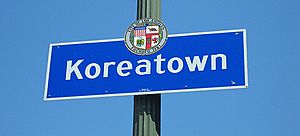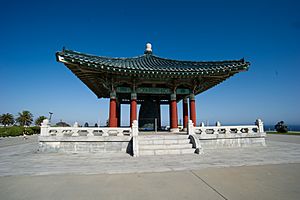History of Korean Americans in Greater Los Angeles facts for kids

Los Angeles is home to the largest Korean community in the United States. In 2008, about 60,000 people of Korean heritage lived in the greater Los Angeles area. This made up 15% of all Korean Americans in the country. It's a vibrant community with a rich history and culture.
Contents
History of Koreans in Los Angeles
Early Korean Settlers
The first Korean immigrants arrived in Los Angeles a long time ago. They settled near Bunker Hill. These early settlers worked in different jobs. Some were farmers, others worked as domestic helpers or waiters.
In 1905, the Korean United Presbyterian Church was built. It was on West Jefferson Boulevard. A small Korean community grew around this church. It became a central place for new immigrants.
Ahn Chang Ho and Old Koreatown
A famous Korean leader, Ahn Chang Ho, had a home that became a community hub. It helped new Korean immigrants find guidance and support. This home also had grocery stores and offices for important Korean groups.
By the 1930s, more Koreans moved to an area near Jefferson Boulevard. This place became known as "Old Koreatown." It was close to the University of Southern California. The children of the first immigrants grew up in this area.
New Waves of Immigration
After the Korean War in the 1950s, more Koreans came to Los Angeles. Then, a law called the Hart-Cellar Act in 1965 made it easier for even more Koreans to immigrate.
After the Watts Riots in 1965, many Koreans started moving to suburbs. By 1970, a large number of Koreans in the U.S. lived in Los Angeles and Orange Counties. Around this time, the main Korean community moved to Olympic Boulevard. This is where the modern Koreatown is located today.
The 1992 Los Angeles Riots
The Korean community faced a very difficult time during the 1992 Los Angeles riots. These events are often called the "4-2-9 riot" by Koreans. This name comes from the date the riots started (April 29th).
Many Korean-owned businesses were damaged or destroyed. The total damage was over $400 million. After the riots, many Koreans moved to suburbs. They went to places like Orange County and the Inland Empire. Since then, Koreatown has been rebuilt and has grown stronger.
Where Koreans Live in Los Angeles
Koreatown and Beyond
As of 2008, about 350,000 people of Korean heritage lived in Los Angeles County. The biggest Korean community is still Koreatown. Most Koreans in Los Angeles live in or near this area.
Korean Communities in the Valleys
By 2008, new Korean communities had also appeared in the northwestern San Fernando Valley. These areas include Chatsworth, Granada Hills, Northridge, and Porter Ranch. In 2008, there were almost 1,500 Korean-owned businesses in the San Fernando Valley. Community leaders estimated that 50,000 to 60,000 Koreans lived there.
Other Growing Communities
Korean communities also grew in other parts of Los Angeles County. These include Cerritos and Hacienda Heights. In Orange County, Korean communities appeared in Buena Park and Fullerton.
Korean Population in Los Angeles
In 2008, about 257,975 Korean Americans lived in the counties of Los Angeles, Orange, Ventura, San Bernardino, and Riverside. This was about 25% of all Korean Americans in the U.S. In Koreatown itself, over 46,000 Koreans lived there. They made up about 20.1% of the residents. Koreatown is a diverse place with many different ethnic groups living together.
Korean Businesses and Economy
By 1988, many Korean stores had opened in different neighborhoods across Los Angeles. Korean clothing manufacturers often hired Hispanic workers. They then sold their products to larger clothing companies.
In 2014, the government investigated some businesses for financial activities. After this, some Korean business owners thought about moving their operations out of Los Angeles. They mentioned fewer customers from Latin America, rising minimum wages, and stricter rules as reasons.
Korean Culture in Los Angeles
A special cultural landmark is the Korean Bell of Friendship. It is located in San Pedro. This large, beautiful bell was a gift from South Korea to the United States. It symbolizes the friendship between the two countries.
Education for Korean Americans
Day Schools
The Wilshire Private School is a private school located in Koreatown. It was formerly known as Hankook School. The Korean Institute of Southern California (KISC) runs this school.
In the past, children of the first Korean immigrants attended schools like Los Angeles High School, Manual Arts High School, and the James A. Foshay Learning Center.
Weekend Language Schools
Many Korean American children attend weekend schools to learn the Korean language and culture. The KISC and the Korean School Association of America (KSAA) operate these schools. In 2003, KISC had 12 schools with over 5,000 students. The KSAA had 244 schools with over 13,000 students. By 2005, the number of KSAA-registered schools grew to 254. These schools help young Koreans connect with their heritage.
Notable People from the Korean Community
Many talented people from the Korean community in Los Angeles have become well-known:
- Philip Ahn - An actor
- Steven Choi - A politician from Orange County
- Joshua Hong - A singer and member of the group Seventeen
- Young Kim - A politician and congresswoman from Orange County
- Grace Lee - A film director
- Hee Sook Lee - A businesswoman who founded the BCD Tofu House chain
- Lena Park - A singer
- Jessica Jung - A singer and former member of Girls' Generation
- Krystal Jung - A singer from the group F(x)
- Michelle Steel - A local congresswoman
- Dumbfoundead - A rapper
- Song Oh-kyun - A Korean Independence Activist
- Tiffany Young - An actress and member of Girls' Generation
- Cathy Park Hong - A poet and writer, author of Minor Feelings: An Asian American Reckoning
- Roy Choi - A famous chef and founder of Kogi


